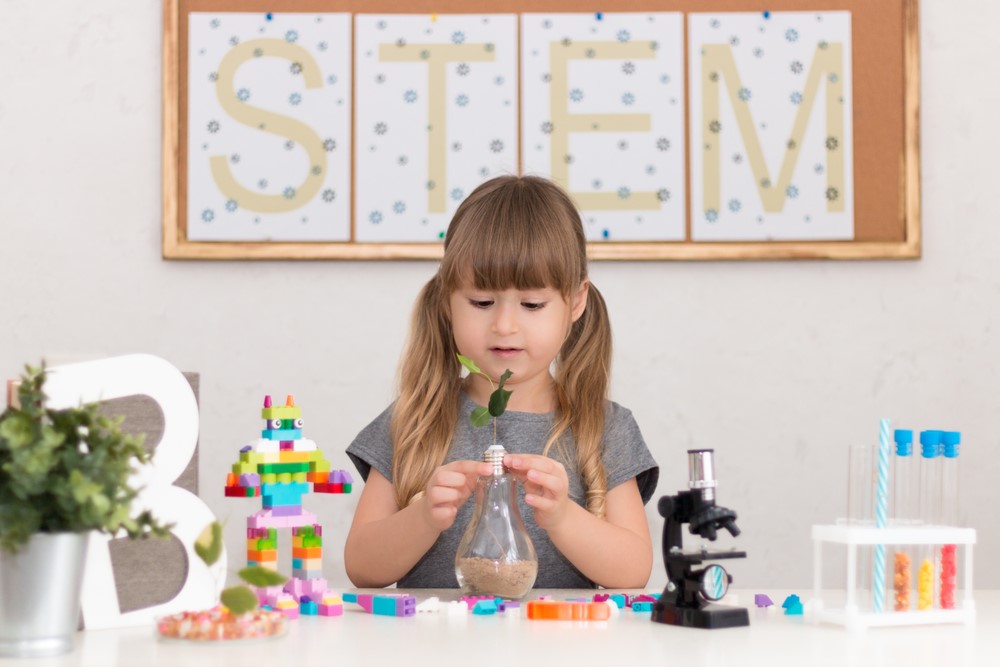
Most likely, you already know that science, technology, engineering and mathematics (STEM) are underrepresented in education. To break it down, only about 20 percent of students meet STEM benchmarks set forth by the standardized test nonprofit ACT. Despite this, STEM careers are more in-demand than ever and are among the highest-paying jobs in America, with STEM-majoring college grads pulling in an average of about $15,500 more per year than their non-STEM counterparts. But STEM education needs to start early and sustain throughout high school in order to capture a student’s interest in adulthood.
Experts say that early childhood is the very best time to start teaching STEM and introducing youngsters to these fields should start before preschool. Here are some of the reasons why scientists and educators agree on “the earlier, the better” when it comes to STEM education.
- They Smash the Notion that STEM Is “Hard”—Did you know that about half of adults believe that more students don’t pursue STEM because the field is too hard? In other words, there’s a good chance a child’s role model has affected his or her view of these subjects, perhaps painting them as unattainable or off-limits to people with average learning capacity. In truth, introducing kids to STEM at a younger age through STEM toys instills an early sense of confidence, teaching them that math and science are conquerable subjects that they can learn. When they find that they can master a science or engineering toy or game, they know they can succeed in the subject and aren’t afraid to explore it later in life.
- They Introduce Kids to Various Sciences—STEM toys are a fantastic way to hone fundamental, lifelong interests in children as young as 3. They’re especially great at instilling the notion that there are many different disciplines within STEM, and that all of them can be fun and interesting. That coding robot could inspire a future software engineer. That microscope kit could kick things off for a someday scientist. That kids’ telescope might be all it takes to set a kid up for her future working on the International Space Station. Letting youngsters explore various disciplines early makes them feel unconfined by precedent or expectation.
- They Teach Problem Solving—Perhaps one of the biggest benefits of STEM toys for young children is that they encourage healthy cognitive development, and specifically sharpen a child’s independence and ability to overcome challenges. Many toys in this category present youngsters with various perceived challenges and problems that the child must work out in order to “win” the game. Instilling problem-solving exercises early in life can help set children up for a productive, independent future.
- As Cliché as It Sounds, They Make Learning Fun—It’s a fundamental rule of parenting and education: The best way to teach is to make whatever you’re teaching fun! STEM games and toys help kids associate science with fun, freedom and discovery. Whether it’s building complex, intricate structures with LEGOs or engineering a gadget from the ground up, STEM-focused playtime is always enjoyable. It also helps youngsters connect learning and problem-solving with pleasure and pride, a connection that they will carry throughout their lives.
- They Appeal to All Kinds of Kids—The fact that women and minorities are still underrepresented in STEM is a big challenge in education. We know that white men have dominated this field primarily due to centuries-old cultural standards and expectations, but now that the doors have been kicked wide open for women and minorities, why aren’t more joining the fight? Only 26 percent of STEM occupations are held by women, while blacks hold only 6 percent and Hispanics hold only 7 percent. Giving all kids early exposure to STEM subjects lets them know that there is no subject that they cannot conquer—even the ones that were historically off-limits to them—and helps encourage more inclusion in the sector.
- They Encourage Creativity and Critical Thinking—Who says mathematicians and scientists can’t be creative, too? Like any play session, engaging in a STEM-focused activity helps introduce kids to the process of creative decision-making. Perhaps more than any other type of a toy, a science or technology toy introduces kids to several options and illustrates how each decision made triggers a different outcome. This naturally fosters both creativity and critical thinking, while giving kids the courage to safely experiment.
- They Teach Motor Skills and Coordination—We often think about science and tech toys as stimulators for the mind, but they’re also very good at helping little ones develop their fine motor skills and hand-eye coordination. This is one of the reasons why science-focused toys are especially ideal for early learners who are still in the midst of strong developmental spurts. Watching kids tinker with building blocks and puzzles, you’ll see them become more confident physically and intellectually at the same time.
- They Bring Together the Whole Family—Another great thing about STEM toys is that they often require the collaboration of both parent and child and are a great way to bring together the whole family for some learning-based fun. By the way, if you’re a grown-up, we encourage you to take a stroll through the educational section the next time you’re at the toy store—these toys are just as fun for us as they are for the kids, so you’ll definitely want to partake!
The Message: STEM Is for Everyone
At their core, what STEM toys do is break down boundaries and challenge stereotypes, from the idea that girls can’t be scientists to the notion that math and creativity don’t mix. In fact, one of the most appealing parts about STEM is that it’s truly limitless—there’s so much more for future generations to discover, and we need to set them up for success no matter what!




